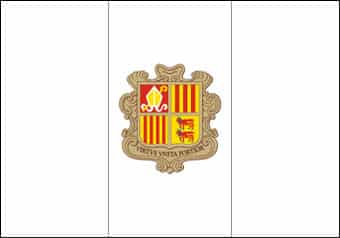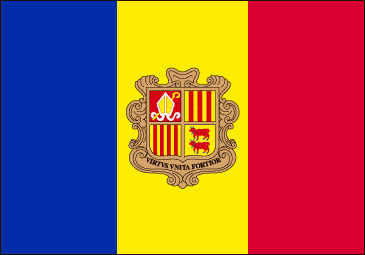
About Flag of Andorra
The flags of Spain and France, the two nations tasked with defending the sovereignty of this little nation, served as the inspiration for Andorra’s flag.
The national flag of Andorra consists of the country’s coat of arms in the middle of three vertical blue, yellow, and red bands. As blue and red were borrowed from France and red and yellow were borrowed from Spain, these colours signify Andorra’s independence from both countries.At the bottom of the coat of arms is a slogan that translates to “Strength United is Stronger.”
Historical Background
The current design of the Andorra flag was adopted on August 27, 1866, although earlier versions of the flag existed. Throughout its history, Andorra has been influenced by neighboring countries, which is reflected in the flag’s design.
| Official Name: | The Principality of Andorra |
| Proportion: | 7:10 |
| Adopted on: | 1866 |
| Location of the country: | Southwestern Europe, located between France and Spain |
| Capital City: | Andorra la Vella |
| Major Cities: | La Massana, Canillo, Sant Julia de Loria, Arinsal |
| Area: | 180.55 square miles |
| Population: | 78,115 |
| Currency: | Euro (EUR) |
| Official Language: | Catalan |
| National Anthem: | The Great Charlemagne, my Father |
| National symbol(s): | |
| National colors: | blue, yellow, red |
| National anthem: | |
| Name: | “El Gran Carlemany” (The Great Charlemagne) |
| Lyrics/music: | Joan BENLLOCH i VIVO/Enric MARFANY BONS |
Facts about Andorra flag |
| Country | Andorra |
|---|---|
| Designed by | NA |
| Adopted | Aug 27, 1971 |
| Revision | NA |
| Design and Colors | A vertical tricolour of blue, yellow and red with the national coat of arms centred on the middle stripe. The middle stripe is one eighth thicker than the outer bands. |
| Size Ratio | 07:10 |
Design and Colors
The Andorra flag features three vertical stripes of equal width. The outer stripes are blue, while the center stripe is yellow. In the upper hoist-side corner of the flag, there is the coat of arms of Andorra, which consists of a quartered shield surrounded by a mitre (bishop’s hat) and two keys.
Symbolism of the Andorra Flag
The colors and symbols on the Andorra flag carry significant meaning. The blue stripes represent France, while the yellow stripe symbolizes Spain, reflecting the historical co-principality of Andorra shared between these two countries. The coat of arms represents Andorra’s unique political and cultural status as a principality under the joint sovereignty of the Bishop of Urgell in Spain and the President of France.
Usage and Protocol
The Andorra flag is proudly displayed throughout the principality on various occasions of national importance. It is hoisted on public buildings, private residences, and during national celebrations and events. The flag should be treated with respect and should not touch the ground or be flown in a tattered condition.
National Day and Flag Day
September 8th is celebrated as the National Day of Andorra, also known as Meritxell Day, honoring the patron saint of Andorra. On this day, the Andorra flag takes center stage, and celebrations, parades, and cultural events are held throughout the principality to commemorate Andorran heritage and identity. More Info
FAQs
Q1: When was the current design of the Andorra flag adopted?
The current design of the Andorra flag was adopted on August 27, 1866.
Q2: What do the blue and yellow colors on the Andorra flag represent?
The blue stripes on the flag represent France, while the yellow stripe represents Spain, reflecting the historical co-principality of Andorra shared between these two countries.
Q3: What is the significance of the coat of arms on the Andorra flag?
The coat of arms represents Andorra’s unique political and cultural status as a principality under the joint sovereignty of the Bishop of Urgell in Spain and the President of France.
Q4: When is the National Day of Andorra celebrated?
The National Day of Andorra, also known as Meritxell Day, is celebrated on September 8th each year.
Q5: How is the Andorra flag celebrated on National Day?
On National Day, the Andorra flag takes center stage during celebrations, parades, and cultural events held throughout the principality to honor Andorran heritage and identity.

